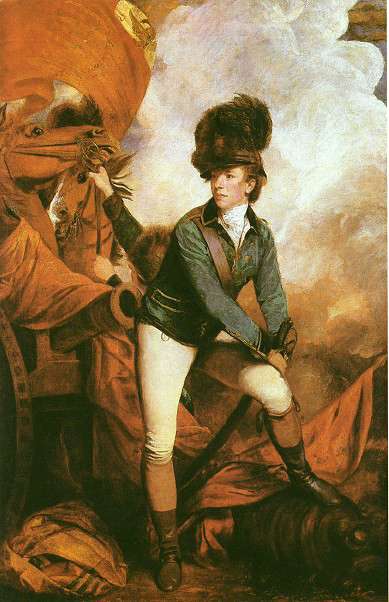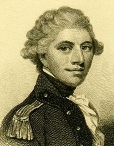 Ban,
by Reynolds, 1782
Ban,
by Reynolds, 1782 Ban,
by Reynolds, 1782
Ban,
by Reynolds, 1782 Even
defeat couldn't separate the dynamic duo. In postwar England, Hanger
and Tarleton formed the core of the Prince of Wales' Rat Pack. When
not racing turkeys against geese or orchestrating riots on behalf of
Whig candidates, the two carried on epic romances. Tarleton's
inamorata was the poetess Mary Darby Robinson, whose polemics against
marriage have just begun to earn recognition from feminist critics.
Hanger, more gourmand than gourmet, preferred professionals, whom he
eulogized in his memoirs as "The Lovely Cyprians."
Even
defeat couldn't separate the dynamic duo. In postwar England, Hanger
and Tarleton formed the core of the Prince of Wales' Rat Pack. When
not racing turkeys against geese or orchestrating riots on behalf of
Whig candidates, the two carried on epic romances. Tarleton's
inamorata was the poetess Mary Darby Robinson, whose polemics against
marriage have just begun to earn recognition from feminist critics.
Hanger, more gourmand than gourmet, preferred professionals, whom he
eulogized in his memoirs as "The Lovely Cyprians."Time's trophy gained and sheathed the
warrior's sword,
And sated him from the world's renown
To die the humble soldier of his Lord,
And change earth's laurel for a Heavenly crown.
 Ban
Tarleton has, unfortunately and rather unjustly, got a bad name as
'Bloody Ban', 'The Butcher of the Carolinas'. A myth has grown up,
embodied by the negative caricature of him in The
Patriot,
that he had a deliberate "policy" of not taking prisoners and
slaughtering surrendering troops: 'TARLETON'S QUARTER'. This is
factually inaccurate.
Ban
Tarleton has, unfortunately and rather unjustly, got a bad name as
'Bloody Ban', 'The Butcher of the Carolinas'. A myth has grown up,
embodied by the negative caricature of him in The
Patriot,
that he had a deliberate "policy" of not taking prisoners and
slaughtering surrendering troops: 'TARLETON'S QUARTER'. This is
factually inaccurate.